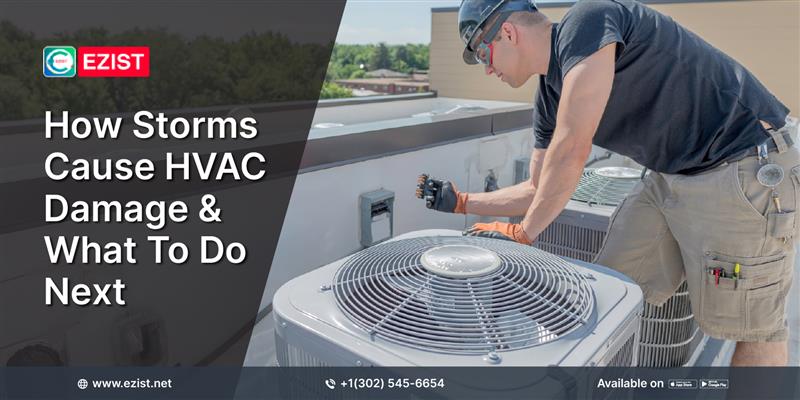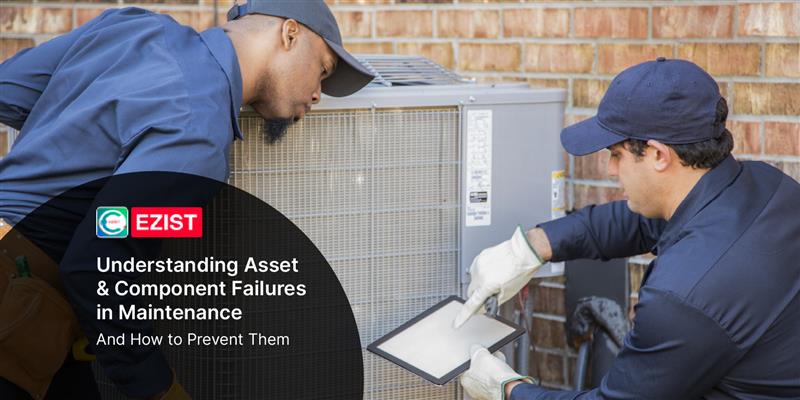
Storms in Virginia are becoming more frequent and severe. From heavy winds to lightning strikes and flash flooding, storm-related damage to HVAC systems is a growing concern for homeowners and property managers across the state.
If your heating and cooling system was affected by a recent storm or if you want to avoid costly damage in the future, this guide is for you. You will learn how storms damage HVAC systems, what signs to look for, what to do next, and how EZIST can help you manage and protect your equipment using free asset management tools.
Virginia experiences dozens of intense thunderstorms, tropical storms, and even hurricanes every year. These weather events can severely impact your HVAC system in the following ways:
Electrical storms can send voltage spikes through your home’s wiring. These surges often damage control boards, capacitors, compressors, and motors in your HVAC unit.
Strong winds can blow branches and other debris into outdoor condenser units. This can bend fan blades, dent the housing, dislodge parts, or knock the unit off its base entirely.
Heavy rain can flood low-lying units or basements where HVAC components are stored. Water can corrode metal parts, destroy electrical wiring, and cause mold growth inside ductwork.
Large hailstones can dent the aluminum fins on your condenser coils. This reduces airflow and can lead to overheating and mechanical failure.
Storms may shift the position of your HVAC unit or loosen connections, reducing performance and increasing wear and tear over time.
Knowing what to look for after a storm helps you take quick action before small problems become expensive repairs.
| Symptom | Possible Cause |
| The HVAC unit will not turn on | Surge damage to electrical components |
| Unusual noises | Bent fan blades or internal debris |
| Weak airflow or poor cooling | Blocked coils or a damaged compressor |
| Dents or cracked panels | Impact from debris or hail |
| Tripped breaker or burning smell | An electrical short caused by moisture |
If your HVAC unit shows signs of damage after a storm, follow these steps to stay safe and protect your investment.
Shut off the unit at the breaker to prevent further electrical damage or risk of shock.
Check the unit for obvious signs of damage like dents, broken parts, water pooling, or exposed wires.
Do not attempt to restart or repair the unit yourself. Contact a licensed HVAC technician in Virginia who has experience with storm-related damage.
Take clear photos and videos of the damage. Save repair invoices and inspection reports to support your insurance claim.
Use EZIST’s free asset management software to log the damage, schedule inspections, and receive maintenance reminders.
Storm damage is often unpredictable, but managing your HVAC system does not have to be. EZIST offers a free asset tracking app that simplifies HVAC service management.
With our platform, you can:
This is especially helpful for landlords, real estate investors, HOAs, and commercial building managers across Virginia.
Repair costs vary based on the type and severity of damage. Here are some average estimates:
| Damage Type | Average Cost |
| Control board replacement | 300 to 700 dollars |
| Compressor failure | 1500 to 3000 dollars |
| Hail-damaged condenser coil | 1000 to 2500 dollars |
| Water-damaged ductwork | 2000 dollars or more |
Waiting too long to fix storm damage can lead to higher repair bills and even full system replacement.
Request fast, reliable service from certified HVAC professionals in Virginia.
Is HVAC storm damage covered by insurance in Virginia?
Yes. Most homeowners’ insurance policies cover HVAC damage caused by lightning, wind, and hail. You will need proof of damage and a professional inspection to support your claim.
How do I know if my HVAC system was damaged by a power surge?
If your HVAC stopped working after a storm and shows signs like a burning smell, tripped breaker, or no power, it is likely surge damage. A certified HVAC technician can confirm it.
Can I prevent future storm damage to my HVAC system?
Yes. Install a surge protector, keep the area around your unit clear, trim nearby trees, and elevate your system if flooding is a concern. Schedule seasonal maintenance to identify weak points.
What is the best way to track HVAC damage and maintenance history?
Use EZIST’s free asset management software. It allows you to log your unit’s details, track inspections, upload photos, and set service reminders.
Where can I find reliable HVAC storm repair in Virginia?
EZIST connects you with trusted HVAC service professionals across Virginia who are experienced in handling storm-related repairs and system restoration.
Storm season in Virginia is not slowing down. Whether you are in Richmond, Virginia Beach, Norfolk, or Roanoke, your HVAC system is at risk.
Here is how EZIST can help:
Visit EZIST.net to schedule your HVAC inspection or start using our free asset management software today.
Do not wait until your HVAC fails during the next storm. Take control now.






